Assignment on Aspect of Nursing Policy and Procedures
VerifiedAdded on 2020/04/29
|16
|3931
|50
AI Summary
Contribute Materials
Your contribution can guide someone’s learning journey. Share your
documents today.

Running head: NURSING ASSIGNMENT
Nursing Assignment
Name of the student
University name
Author’s note
Nursing Assignment
Name of the student
University name
Author’s note
Secure Best Marks with AI Grader
Need help grading? Try our AI Grader for instant feedback on your assignments.
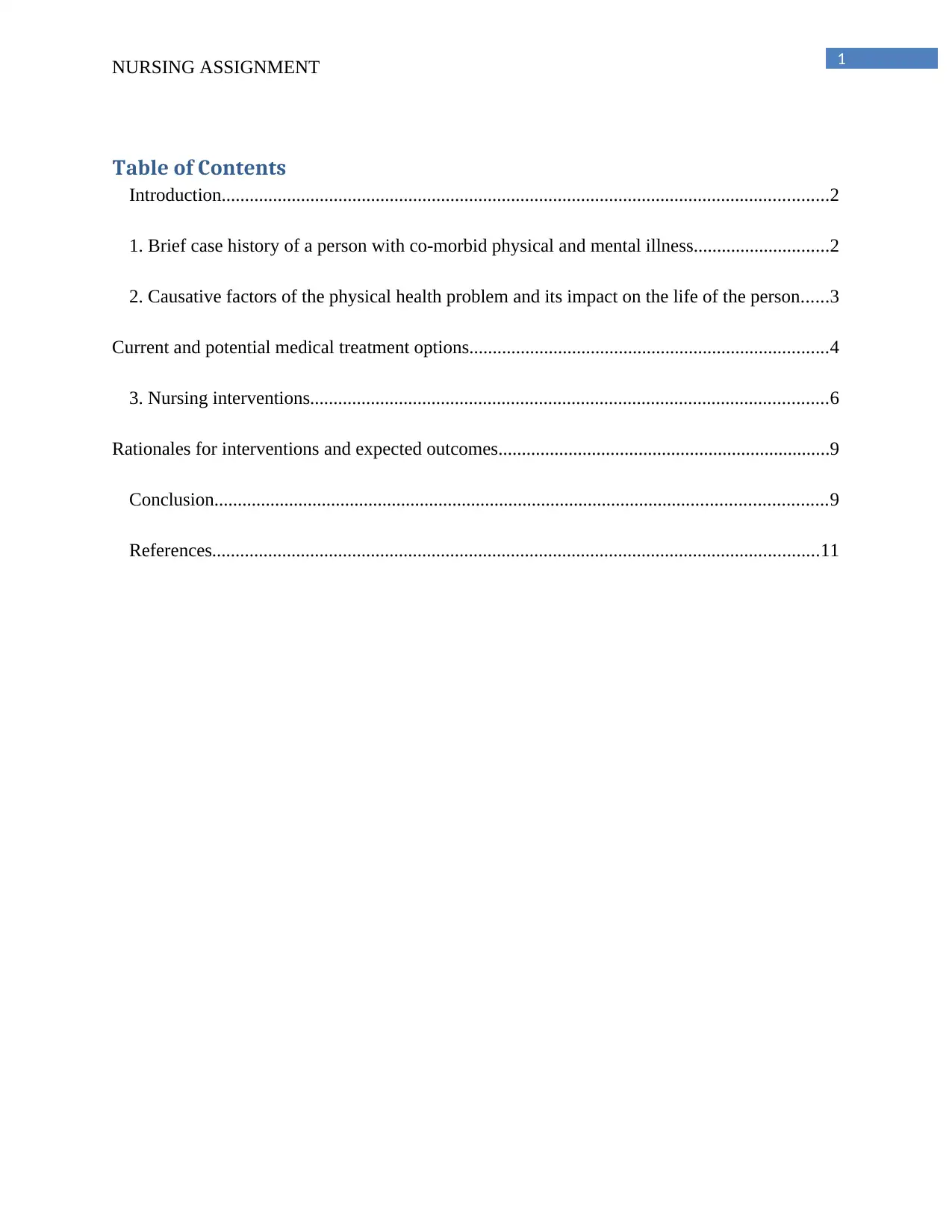
1NURSING ASSIGNMENT
Table of Contents
Introduction..................................................................................................................................2
1. Brief case history of a person with co-morbid physical and mental illness.............................2
2. Causative factors of the physical health problem and its impact on the life of the person......3
Current and potential medical treatment options.............................................................................4
3. Nursing interventions...............................................................................................................6
Rationales for interventions and expected outcomes.......................................................................9
Conclusion...................................................................................................................................9
References..................................................................................................................................11
Table of Contents
Introduction..................................................................................................................................2
1. Brief case history of a person with co-morbid physical and mental illness.............................2
2. Causative factors of the physical health problem and its impact on the life of the person......3
Current and potential medical treatment options.............................................................................4
3. Nursing interventions...............................................................................................................6
Rationales for interventions and expected outcomes.......................................................................9
Conclusion...................................................................................................................................9
References..................................................................................................................................11
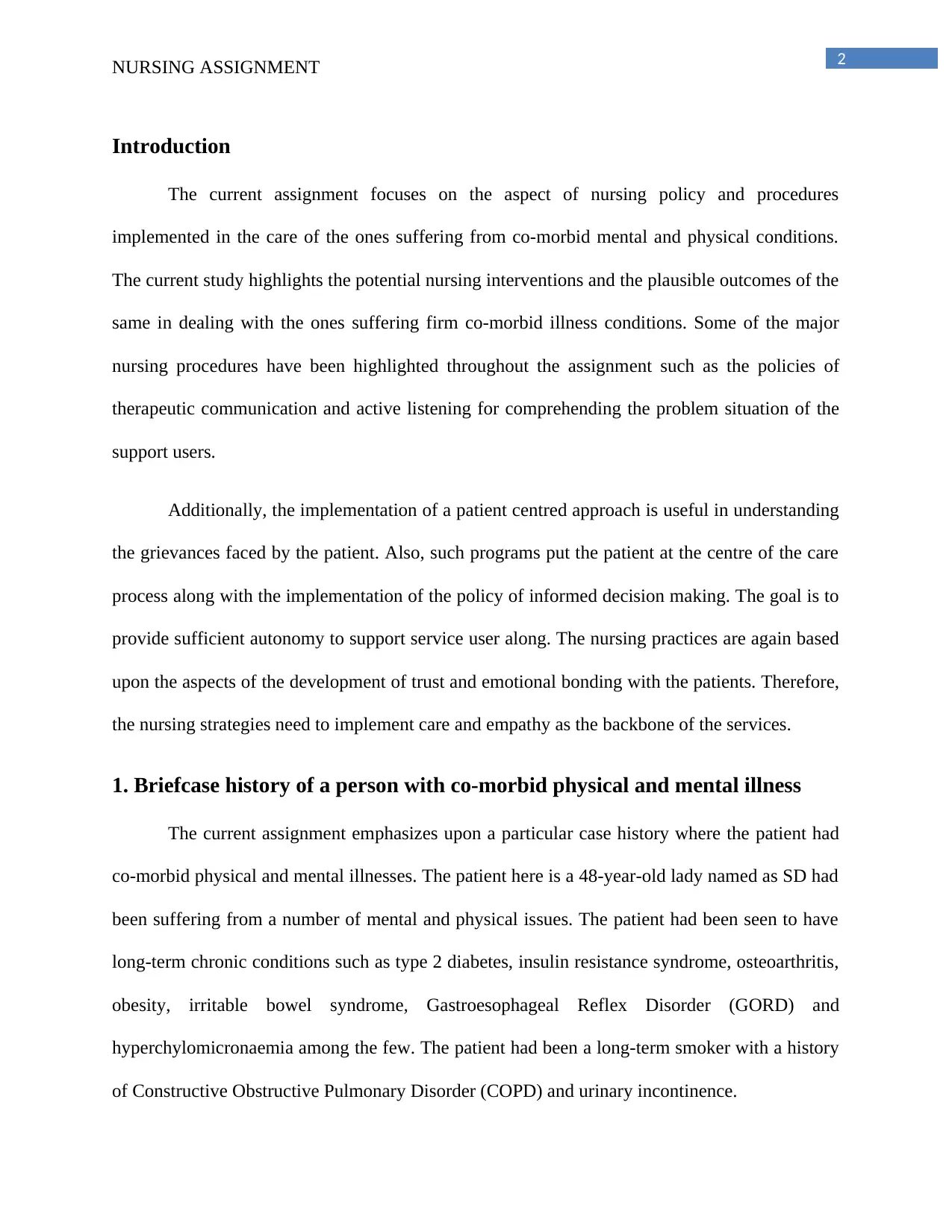
2NURSING ASSIGNMENT
Introduction
The current assignment focuses on the aspect of nursing policy and procedures
implemented in the care of the ones suffering from co-morbid mental and physical conditions.
The current study highlights the potential nursing interventions and the plausible outcomes of the
same in dealing with the ones suffering firm co-morbid illness conditions. Some of the major
nursing procedures have been highlighted throughout the assignment such as the policies of
therapeutic communication and active listening for comprehending the problem situation of the
support users.
Additionally, the implementation of a patient centred approach is useful in understanding
the grievances faced by the patient. Also, such programs put the patient at the centre of the care
process along with the implementation of the policy of informed decision making. The goal is to
provide sufficient autonomy to support service user along. The nursing practices are again based
upon the aspects of the development of trust and emotional bonding with the patients. Therefore,
the nursing strategies need to implement care and empathy as the backbone of the services.
1. Briefcase history of a person with co-morbid physical and mental illness
The current assignment emphasizes upon a particular case history where the patient had
co-morbid physical and mental illnesses. The patient here is a 48-year-old lady named as SD had
been suffering from a number of mental and physical issues. The patient had been seen to have
long-term chronic conditions such as type 2 diabetes, insulin resistance syndrome, osteoarthritis,
obesity, irritable bowel syndrome, Gastroesophageal Reflex Disorder (GORD) and
hyperchylomicronaemia among the few. The patient had been a long-term smoker with a history
of Constructive Obstructive Pulmonary Disorder (COPD) and urinary incontinence.
Introduction
The current assignment focuses on the aspect of nursing policy and procedures
implemented in the care of the ones suffering from co-morbid mental and physical conditions.
The current study highlights the potential nursing interventions and the plausible outcomes of the
same in dealing with the ones suffering firm co-morbid illness conditions. Some of the major
nursing procedures have been highlighted throughout the assignment such as the policies of
therapeutic communication and active listening for comprehending the problem situation of the
support users.
Additionally, the implementation of a patient centred approach is useful in understanding
the grievances faced by the patient. Also, such programs put the patient at the centre of the care
process along with the implementation of the policy of informed decision making. The goal is to
provide sufficient autonomy to support service user along. The nursing practices are again based
upon the aspects of the development of trust and emotional bonding with the patients. Therefore,
the nursing strategies need to implement care and empathy as the backbone of the services.
1. Briefcase history of a person with co-morbid physical and mental illness
The current assignment emphasizes upon a particular case history where the patient had
co-morbid physical and mental illnesses. The patient here is a 48-year-old lady named as SD had
been suffering from a number of mental and physical issues. The patient had been seen to have
long-term chronic conditions such as type 2 diabetes, insulin resistance syndrome, osteoarthritis,
obesity, irritable bowel syndrome, Gastroesophageal Reflex Disorder (GORD) and
hyperchylomicronaemia among the few. The patient had been a long-term smoker with a history
of Constructive Obstructive Pulmonary Disorder (COPD) and urinary incontinence.
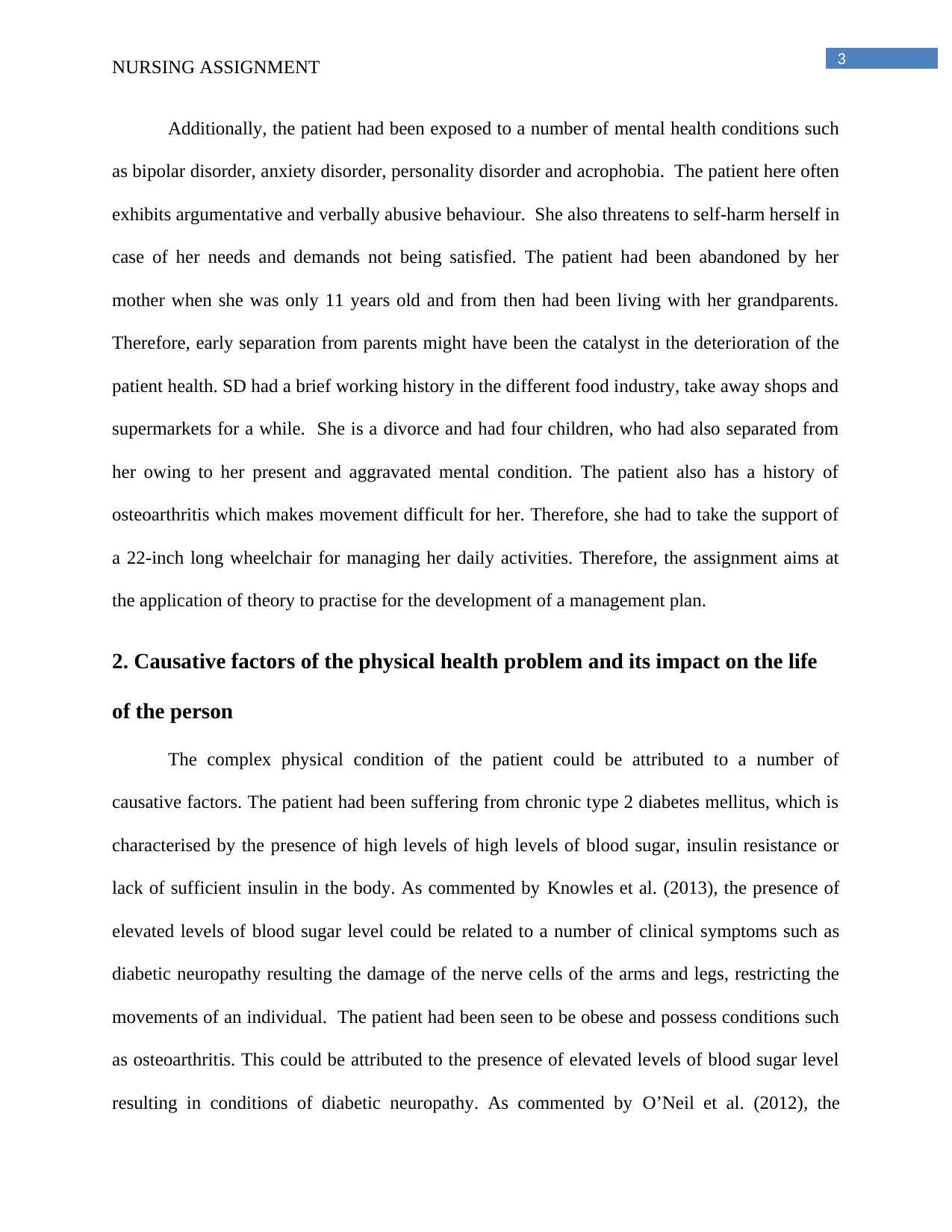
3NURSING ASSIGNMENT
Additionally, the patient had been exposed to a number of mental health conditions such
as bipolar disorder, anxiety disorder, personality disorder and acrophobia. The patient here often
exhibits argumentative and verbally abusive behaviour. She also threatens to self-harm herself in
case of her needs and demands not being satisfied. The patient had been abandoned by her
mother when she was only 11 years old and from then had been living with her grandparents.
Therefore, early separation from parents might have been the catalyst in the deterioration of the
patient health. SD had a brief working history in the different food industry, take away shops and
supermarkets for a while. She is a divorce and had four children, who had also separated from
her owing to her present and aggravated mental condition. The patient also has a history of
osteoarthritis which makes movement difficult for her. Therefore, she had to take the support of
a 22-inch long wheelchair for managing her daily activities. Therefore, the assignment aims at
the application of theory to practise for the development of a management plan.
2. Causative factors of the physical health problem and its impact on the life
of the person
The complex physical condition of the patient could be attributed to a number of
causative factors. The patient had been suffering from chronic type 2 diabetes mellitus, which is
characterised by the presence of high levels of high levels of blood sugar, insulin resistance or
lack of sufficient insulin in the body. As commented by Knowles et al. (2013), the presence of
elevated levels of blood sugar level could be related to a number of clinical symptoms such as
diabetic neuropathy resulting the damage of the nerve cells of the arms and legs, restricting the
movements of an individual. The patient had been seen to be obese and possess conditions such
as osteoarthritis. This could be attributed to the presence of elevated levels of blood sugar level
resulting in conditions of diabetic neuropathy. As commented by O’Neil et al. (2012), the
Additionally, the patient had been exposed to a number of mental health conditions such
as bipolar disorder, anxiety disorder, personality disorder and acrophobia. The patient here often
exhibits argumentative and verbally abusive behaviour. She also threatens to self-harm herself in
case of her needs and demands not being satisfied. The patient had been abandoned by her
mother when she was only 11 years old and from then had been living with her grandparents.
Therefore, early separation from parents might have been the catalyst in the deterioration of the
patient health. SD had a brief working history in the different food industry, take away shops and
supermarkets for a while. She is a divorce and had four children, who had also separated from
her owing to her present and aggravated mental condition. The patient also has a history of
osteoarthritis which makes movement difficult for her. Therefore, she had to take the support of
a 22-inch long wheelchair for managing her daily activities. Therefore, the assignment aims at
the application of theory to practise for the development of a management plan.
2. Causative factors of the physical health problem and its impact on the life
of the person
The complex physical condition of the patient could be attributed to a number of
causative factors. The patient had been suffering from chronic type 2 diabetes mellitus, which is
characterised by the presence of high levels of high levels of blood sugar, insulin resistance or
lack of sufficient insulin in the body. As commented by Knowles et al. (2013), the presence of
elevated levels of blood sugar level could be related to a number of clinical symptoms such as
diabetic neuropathy resulting the damage of the nerve cells of the arms and legs, restricting the
movements of an individual. The patient had been seen to be obese and possess conditions such
as osteoarthritis. This could be attributed to the presence of elevated levels of blood sugar level
resulting in conditions of diabetic neuropathy. As commented by O’Neil et al. (2012), the
Secure Best Marks with AI Grader
Need help grading? Try our AI Grader for instant feedback on your assignments.
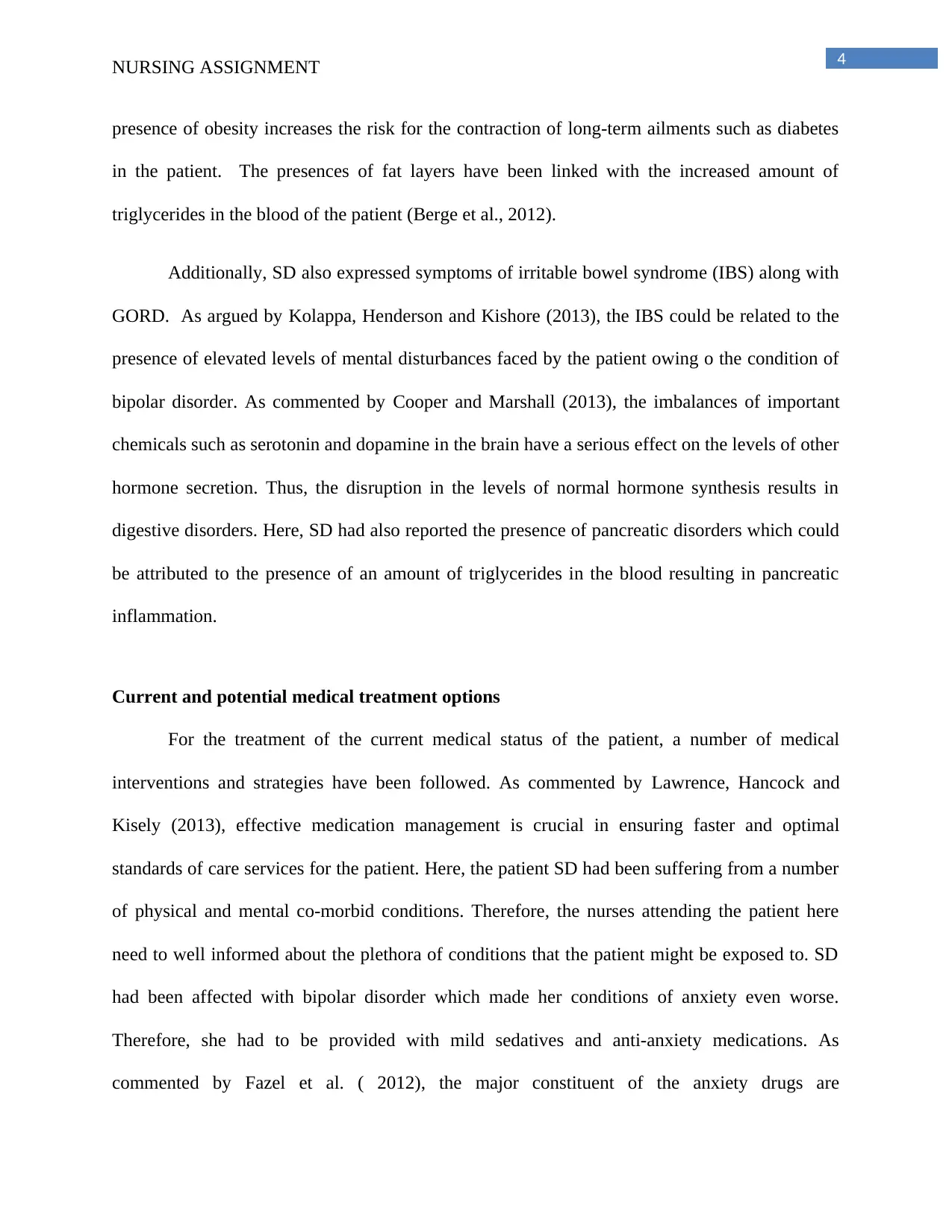
4NURSING ASSIGNMENT
presence of obesity increases the risk for the contraction of long-term ailments such as diabetes
in the patient. The presences of fat layers have been linked with the increased amount of
triglycerides in the blood of the patient (Berge et al., 2012).
Additionally, SD also expressed symptoms of irritable bowel syndrome (IBS) along with
GORD. As argued by Kolappa, Henderson and Kishore (2013), the IBS could be related to the
presence of elevated levels of mental disturbances faced by the patient owing o the condition of
bipolar disorder. As commented by Cooper and Marshall (2013), the imbalances of important
chemicals such as serotonin and dopamine in the brain have a serious effect on the levels of other
hormone secretion. Thus, the disruption in the levels of normal hormone synthesis results in
digestive disorders. Here, SD had also reported the presence of pancreatic disorders which could
be attributed to the presence of an amount of triglycerides in the blood resulting in pancreatic
inflammation.
Current and potential medical treatment options
For the treatment of the current medical status of the patient, a number of medical
interventions and strategies have been followed. As commented by Lawrence, Hancock and
Kisely (2013), effective medication management is crucial in ensuring faster and optimal
standards of care services for the patient. Here, the patient SD had been suffering from a number
of physical and mental co-morbid conditions. Therefore, the nurses attending the patient here
need to well informed about the plethora of conditions that the patient might be exposed to. SD
had been affected with bipolar disorder which made her conditions of anxiety even worse.
Therefore, she had to be provided with mild sedatives and anti-anxiety medications. As
commented by Fazel et al. ( 2012), the major constituent of the anxiety drugs are
presence of obesity increases the risk for the contraction of long-term ailments such as diabetes
in the patient. The presences of fat layers have been linked with the increased amount of
triglycerides in the blood of the patient (Berge et al., 2012).
Additionally, SD also expressed symptoms of irritable bowel syndrome (IBS) along with
GORD. As argued by Kolappa, Henderson and Kishore (2013), the IBS could be related to the
presence of elevated levels of mental disturbances faced by the patient owing o the condition of
bipolar disorder. As commented by Cooper and Marshall (2013), the imbalances of important
chemicals such as serotonin and dopamine in the brain have a serious effect on the levels of other
hormone secretion. Thus, the disruption in the levels of normal hormone synthesis results in
digestive disorders. Here, SD had also reported the presence of pancreatic disorders which could
be attributed to the presence of an amount of triglycerides in the blood resulting in pancreatic
inflammation.
Current and potential medical treatment options
For the treatment of the current medical status of the patient, a number of medical
interventions and strategies have been followed. As commented by Lawrence, Hancock and
Kisely (2013), effective medication management is crucial in ensuring faster and optimal
standards of care services for the patient. Here, the patient SD had been suffering from a number
of physical and mental co-morbid conditions. Therefore, the nurses attending the patient here
need to well informed about the plethora of conditions that the patient might be exposed to. SD
had been affected with bipolar disorder which made her conditions of anxiety even worse.
Therefore, she had to be provided with mild sedatives and anti-anxiety medications. As
commented by Fazel et al. ( 2012), the major constituent of the anxiety drugs are
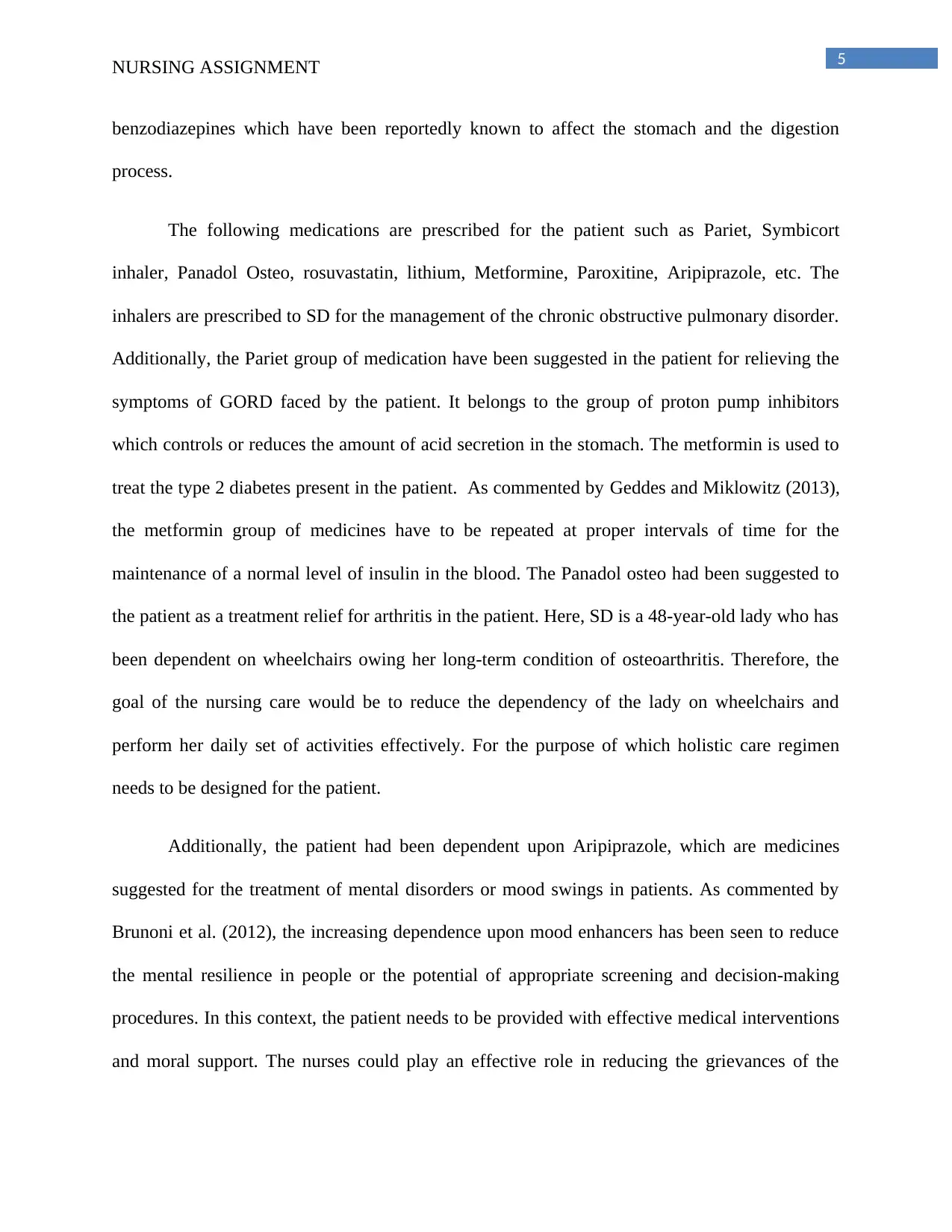
5NURSING ASSIGNMENT
benzodiazepines which have been reportedly known to affect the stomach and the digestion
process.
The following medications are prescribed for the patient such as Pariet, Symbicort
inhaler, Panadol Osteo, rosuvastatin, lithium, Metformine, Paroxitine, Aripiprazole, etc. The
inhalers are prescribed to SD for the management of the chronic obstructive pulmonary disorder.
Additionally, the Pariet group of medication have been suggested in the patient for relieving the
symptoms of GORD faced by the patient. It belongs to the group of proton pump inhibitors
which controls or reduces the amount of acid secretion in the stomach. The metformin is used to
treat the type 2 diabetes present in the patient. As commented by Geddes and Miklowitz (2013),
the metformin group of medicines have to be repeated at proper intervals of time for the
maintenance of a normal level of insulin in the blood. The Panadol osteo had been suggested to
the patient as a treatment relief for arthritis in the patient. Here, SD is a 48-year-old lady who has
been dependent on wheelchairs owing her long-term condition of osteoarthritis. Therefore, the
goal of the nursing care would be to reduce the dependency of the lady on wheelchairs and
perform her daily set of activities effectively. For the purpose of which holistic care regimen
needs to be designed for the patient.
Additionally, the patient had been dependent upon Aripiprazole, which are medicines
suggested for the treatment of mental disorders or mood swings in patients. As commented by
Brunoni et al. (2012), the increasing dependence upon mood enhancers has been seen to reduce
the mental resilience in people or the potential of appropriate screening and decision-making
procedures. In this context, the patient needs to be provided with effective medical interventions
and moral support. The nurses could play an effective role in reducing the grievances of the
benzodiazepines which have been reportedly known to affect the stomach and the digestion
process.
The following medications are prescribed for the patient such as Pariet, Symbicort
inhaler, Panadol Osteo, rosuvastatin, lithium, Metformine, Paroxitine, Aripiprazole, etc. The
inhalers are prescribed to SD for the management of the chronic obstructive pulmonary disorder.
Additionally, the Pariet group of medication have been suggested in the patient for relieving the
symptoms of GORD faced by the patient. It belongs to the group of proton pump inhibitors
which controls or reduces the amount of acid secretion in the stomach. The metformin is used to
treat the type 2 diabetes present in the patient. As commented by Geddes and Miklowitz (2013),
the metformin group of medicines have to be repeated at proper intervals of time for the
maintenance of a normal level of insulin in the blood. The Panadol osteo had been suggested to
the patient as a treatment relief for arthritis in the patient. Here, SD is a 48-year-old lady who has
been dependent on wheelchairs owing her long-term condition of osteoarthritis. Therefore, the
goal of the nursing care would be to reduce the dependency of the lady on wheelchairs and
perform her daily set of activities effectively. For the purpose of which holistic care regimen
needs to be designed for the patient.
Additionally, the patient had been dependent upon Aripiprazole, which are medicines
suggested for the treatment of mental disorders or mood swings in patients. As commented by
Brunoni et al. (2012), the increasing dependence upon mood enhancers has been seen to reduce
the mental resilience in people or the potential of appropriate screening and decision-making
procedures. In this context, the patient needs to be provided with effective medical interventions
and moral support. The nurses could play an effective role in reducing the grievances of the
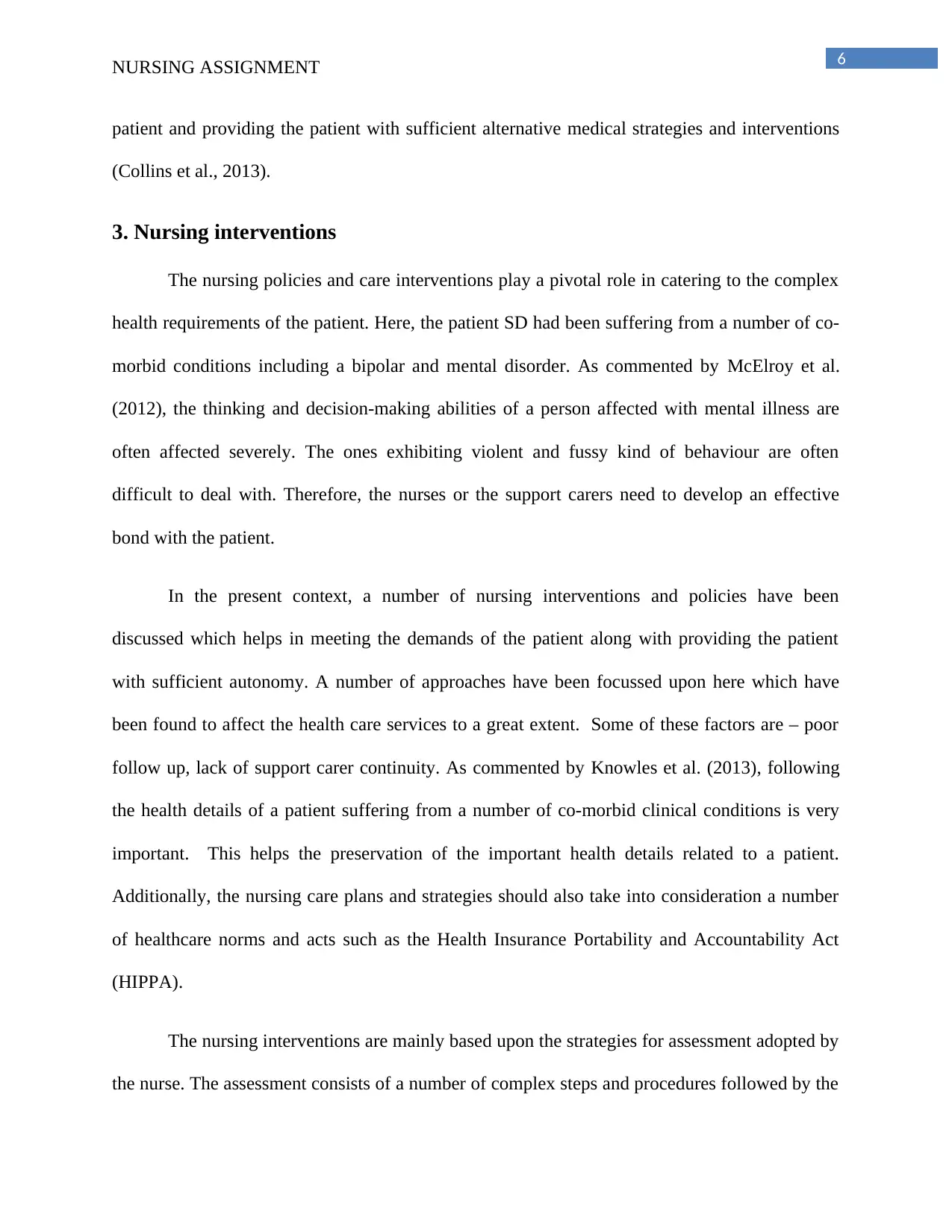
6NURSING ASSIGNMENT
patient and providing the patient with sufficient alternative medical strategies and interventions
(Collins et al., 2013).
3. Nursing interventions
The nursing policies and care interventions play a pivotal role in catering to the complex
health requirements of the patient. Here, the patient SD had been suffering from a number of co-
morbid conditions including a bipolar and mental disorder. As commented by McElroy et al.
(2012), the thinking and decision-making abilities of a person affected with mental illness are
often affected severely. The ones exhibiting violent and fussy kind of behaviour are often
difficult to deal with. Therefore, the nurses or the support carers need to develop an effective
bond with the patient.
In the present context, a number of nursing interventions and policies have been
discussed which helps in meeting the demands of the patient along with providing the patient
with sufficient autonomy. A number of approaches have been focussed upon here which have
been found to affect the health care services to a great extent. Some of these factors are – poor
follow up, lack of support carer continuity. As commented by Knowles et al. (2013), following
the health details of a patient suffering from a number of co-morbid clinical conditions is very
important. This helps the preservation of the important health details related to a patient.
Additionally, the nursing care plans and strategies should also take into consideration a number
of healthcare norms and acts such as the Health Insurance Portability and Accountability Act
(HIPPA).
The nursing interventions are mainly based upon the strategies for assessment adopted by
the nurse. The assessment consists of a number of complex steps and procedures followed by the
patient and providing the patient with sufficient alternative medical strategies and interventions
(Collins et al., 2013).
3. Nursing interventions
The nursing policies and care interventions play a pivotal role in catering to the complex
health requirements of the patient. Here, the patient SD had been suffering from a number of co-
morbid conditions including a bipolar and mental disorder. As commented by McElroy et al.
(2012), the thinking and decision-making abilities of a person affected with mental illness are
often affected severely. The ones exhibiting violent and fussy kind of behaviour are often
difficult to deal with. Therefore, the nurses or the support carers need to develop an effective
bond with the patient.
In the present context, a number of nursing interventions and policies have been
discussed which helps in meeting the demands of the patient along with providing the patient
with sufficient autonomy. A number of approaches have been focussed upon here which have
been found to affect the health care services to a great extent. Some of these factors are – poor
follow up, lack of support carer continuity. As commented by Knowles et al. (2013), following
the health details of a patient suffering from a number of co-morbid clinical conditions is very
important. This helps the preservation of the important health details related to a patient.
Additionally, the nursing care plans and strategies should also take into consideration a number
of healthcare norms and acts such as the Health Insurance Portability and Accountability Act
(HIPPA).
The nursing interventions are mainly based upon the strategies for assessment adopted by
the nurse. The assessment consists of a number of complex steps and procedures followed by the
Paraphrase This Document
Need a fresh take? Get an instant paraphrase of this document with our AI Paraphraser
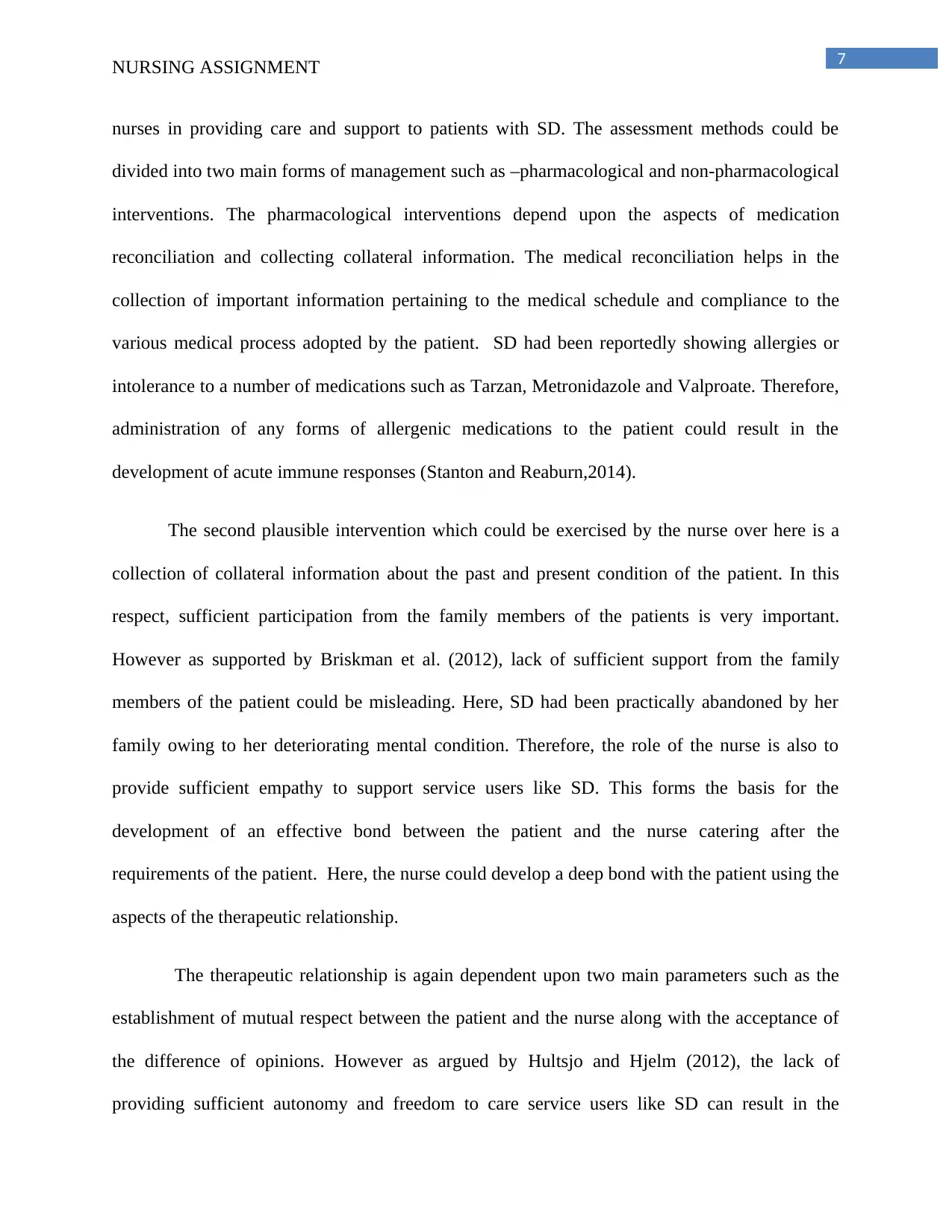
7NURSING ASSIGNMENT
nurses in providing care and support to patients with SD. The assessment methods could be
divided into two main forms of management such as –pharmacological and non-pharmacological
interventions. The pharmacological interventions depend upon the aspects of medication
reconciliation and collecting collateral information. The medical reconciliation helps in the
collection of important information pertaining to the medical schedule and compliance to the
various medical process adopted by the patient. SD had been reportedly showing allergies or
intolerance to a number of medications such as Tarzan, Metronidazole and Valproate. Therefore,
administration of any forms of allergenic medications to the patient could result in the
development of acute immune responses (Stanton and Reaburn,2014).
The second plausible intervention which could be exercised by the nurse over here is a
collection of collateral information about the past and present condition of the patient. In this
respect, sufficient participation from the family members of the patients is very important.
However as supported by Briskman et al. (2012), lack of sufficient support from the family
members of the patient could be misleading. Here, SD had been practically abandoned by her
family owing to her deteriorating mental condition. Therefore, the role of the nurse is also to
provide sufficient empathy to support service users like SD. This forms the basis for the
development of an effective bond between the patient and the nurse catering after the
requirements of the patient. Here, the nurse could develop a deep bond with the patient using the
aspects of the therapeutic relationship.
The therapeutic relationship is again dependent upon two main parameters such as the
establishment of mutual respect between the patient and the nurse along with the acceptance of
the difference of opinions. However as argued by Hultsjo and Hjelm (2012), the lack of
providing sufficient autonomy and freedom to care service users like SD can result in the
nurses in providing care and support to patients with SD. The assessment methods could be
divided into two main forms of management such as –pharmacological and non-pharmacological
interventions. The pharmacological interventions depend upon the aspects of medication
reconciliation and collecting collateral information. The medical reconciliation helps in the
collection of important information pertaining to the medical schedule and compliance to the
various medical process adopted by the patient. SD had been reportedly showing allergies or
intolerance to a number of medications such as Tarzan, Metronidazole and Valproate. Therefore,
administration of any forms of allergenic medications to the patient could result in the
development of acute immune responses (Stanton and Reaburn,2014).
The second plausible intervention which could be exercised by the nurse over here is a
collection of collateral information about the past and present condition of the patient. In this
respect, sufficient participation from the family members of the patients is very important.
However as supported by Briskman et al. (2012), lack of sufficient support from the family
members of the patient could be misleading. Here, SD had been practically abandoned by her
family owing to her deteriorating mental condition. Therefore, the role of the nurse is also to
provide sufficient empathy to support service users like SD. This forms the basis for the
development of an effective bond between the patient and the nurse catering after the
requirements of the patient. Here, the nurse could develop a deep bond with the patient using the
aspects of the therapeutic relationship.
The therapeutic relationship is again dependent upon two main parameters such as the
establishment of mutual respect between the patient and the nurse along with the acceptance of
the difference of opinions. However as argued by Hultsjo and Hjelm (2012), the lack of
providing sufficient autonomy and freedom to care service users like SD can result in the
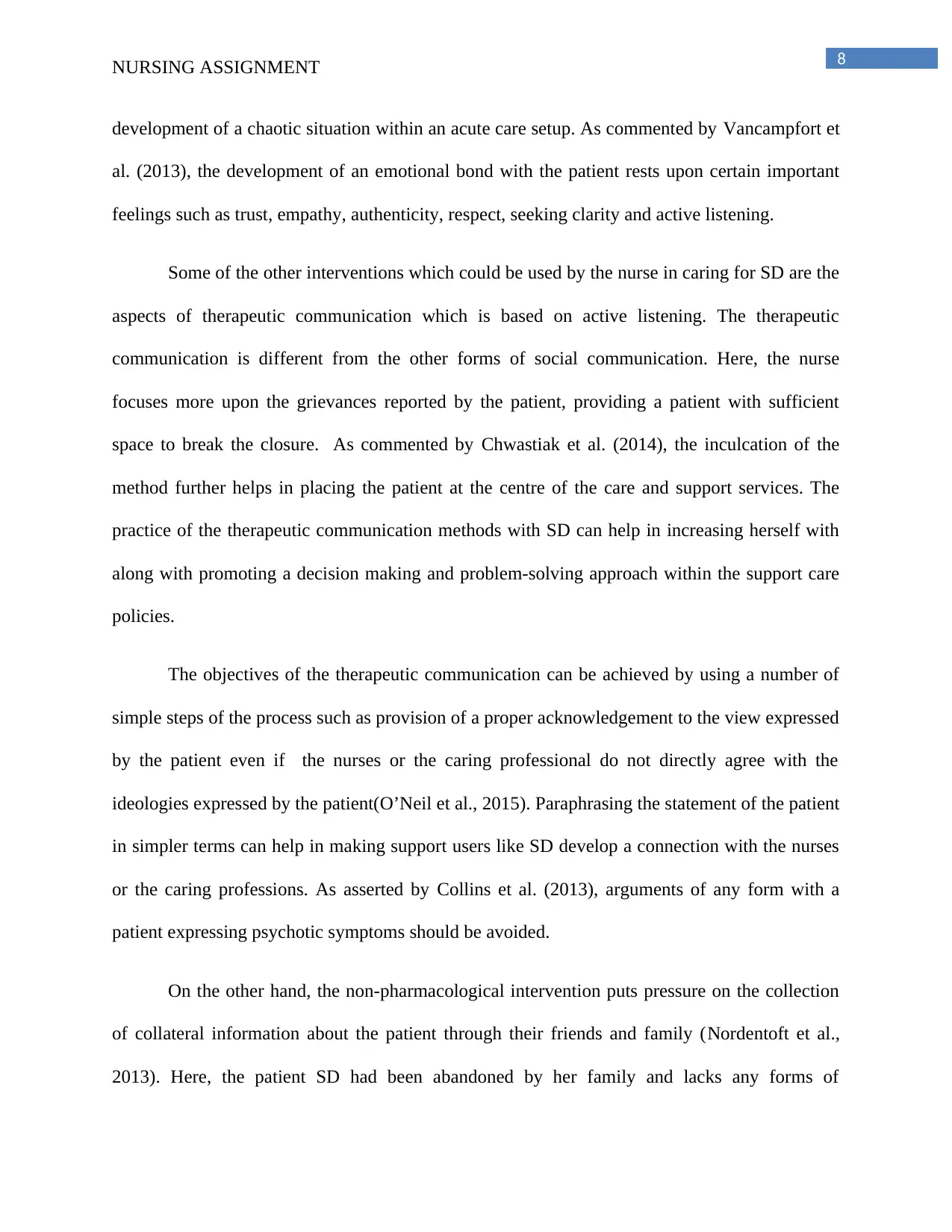
8NURSING ASSIGNMENT
development of a chaotic situation within an acute care setup. As commented by Vancampfort et
al. (2013), the development of an emotional bond with the patient rests upon certain important
feelings such as trust, empathy, authenticity, respect, seeking clarity and active listening.
Some of the other interventions which could be used by the nurse in caring for SD are the
aspects of therapeutic communication which is based on active listening. The therapeutic
communication is different from the other forms of social communication. Here, the nurse
focuses more upon the grievances reported by the patient, providing a patient with sufficient
space to break the closure. As commented by Chwastiak et al. (2014), the inculcation of the
method further helps in placing the patient at the centre of the care and support services. The
practice of the therapeutic communication methods with SD can help in increasing herself with
along with promoting a decision making and problem-solving approach within the support care
policies.
The objectives of the therapeutic communication can be achieved by using a number of
simple steps of the process such as provision of a proper acknowledgement to the view expressed
by the patient even if the nurses or the caring professional do not directly agree with the
ideologies expressed by the patient(O’Neil et al., 2015). Paraphrasing the statement of the patient
in simpler terms can help in making support users like SD develop a connection with the nurses
or the caring professions. As asserted by Collins et al. (2013), arguments of any form with a
patient expressing psychotic symptoms should be avoided.
On the other hand, the non-pharmacological intervention puts pressure on the collection
of collateral information about the patient through their friends and family (Nordentoft et al.,
2013). Here, the patient SD had been abandoned by her family and lacks any forms of
development of a chaotic situation within an acute care setup. As commented by Vancampfort et
al. (2013), the development of an emotional bond with the patient rests upon certain important
feelings such as trust, empathy, authenticity, respect, seeking clarity and active listening.
Some of the other interventions which could be used by the nurse in caring for SD are the
aspects of therapeutic communication which is based on active listening. The therapeutic
communication is different from the other forms of social communication. Here, the nurse
focuses more upon the grievances reported by the patient, providing a patient with sufficient
space to break the closure. As commented by Chwastiak et al. (2014), the inculcation of the
method further helps in placing the patient at the centre of the care and support services. The
practice of the therapeutic communication methods with SD can help in increasing herself with
along with promoting a decision making and problem-solving approach within the support care
policies.
The objectives of the therapeutic communication can be achieved by using a number of
simple steps of the process such as provision of a proper acknowledgement to the view expressed
by the patient even if the nurses or the caring professional do not directly agree with the
ideologies expressed by the patient(O’Neil et al., 2015). Paraphrasing the statement of the patient
in simpler terms can help in making support users like SD develop a connection with the nurses
or the caring professions. As asserted by Collins et al. (2013), arguments of any form with a
patient expressing psychotic symptoms should be avoided.
On the other hand, the non-pharmacological intervention puts pressure on the collection
of collateral information about the patient through their friends and family (Nordentoft et al.,
2013). Here, the patient SD had been abandoned by her family and lacks any forms of
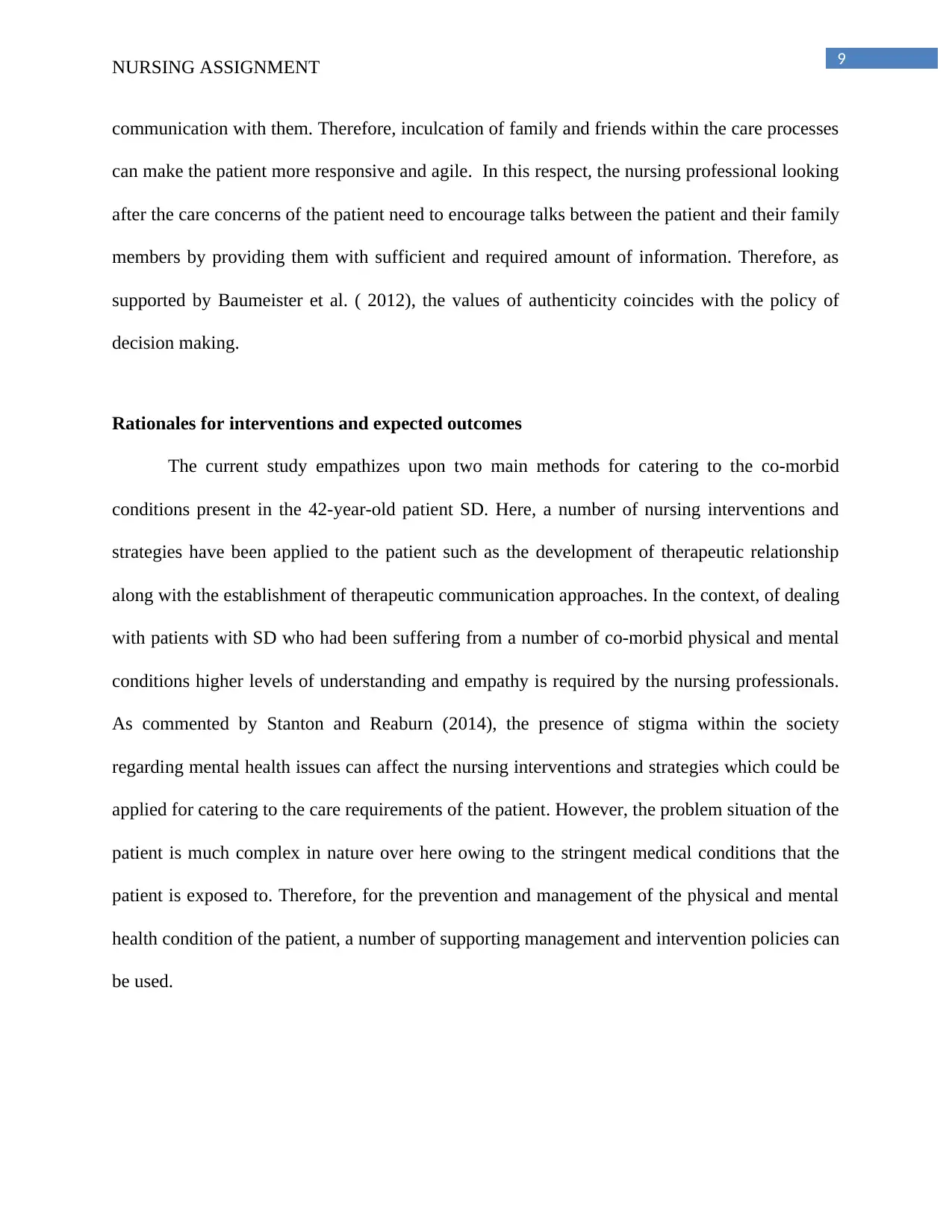
9NURSING ASSIGNMENT
communication with them. Therefore, inculcation of family and friends within the care processes
can make the patient more responsive and agile. In this respect, the nursing professional looking
after the care concerns of the patient need to encourage talks between the patient and their family
members by providing them with sufficient and required amount of information. Therefore, as
supported by Baumeister et al. ( 2012), the values of authenticity coincides with the policy of
decision making.
Rationales for interventions and expected outcomes
The current study empathizes upon two main methods for catering to the co-morbid
conditions present in the 42-year-old patient SD. Here, a number of nursing interventions and
strategies have been applied to the patient such as the development of therapeutic relationship
along with the establishment of therapeutic communication approaches. In the context, of dealing
with patients with SD who had been suffering from a number of co-morbid physical and mental
conditions higher levels of understanding and empathy is required by the nursing professionals.
As commented by Stanton and Reaburn (2014), the presence of stigma within the society
regarding mental health issues can affect the nursing interventions and strategies which could be
applied for catering to the care requirements of the patient. However, the problem situation of the
patient is much complex in nature over here owing to the stringent medical conditions that the
patient is exposed to. Therefore, for the prevention and management of the physical and mental
health condition of the patient, a number of supporting management and intervention policies can
be used.
communication with them. Therefore, inculcation of family and friends within the care processes
can make the patient more responsive and agile. In this respect, the nursing professional looking
after the care concerns of the patient need to encourage talks between the patient and their family
members by providing them with sufficient and required amount of information. Therefore, as
supported by Baumeister et al. ( 2012), the values of authenticity coincides with the policy of
decision making.
Rationales for interventions and expected outcomes
The current study empathizes upon two main methods for catering to the co-morbid
conditions present in the 42-year-old patient SD. Here, a number of nursing interventions and
strategies have been applied to the patient such as the development of therapeutic relationship
along with the establishment of therapeutic communication approaches. In the context, of dealing
with patients with SD who had been suffering from a number of co-morbid physical and mental
conditions higher levels of understanding and empathy is required by the nursing professionals.
As commented by Stanton and Reaburn (2014), the presence of stigma within the society
regarding mental health issues can affect the nursing interventions and strategies which could be
applied for catering to the care requirements of the patient. However, the problem situation of the
patient is much complex in nature over here owing to the stringent medical conditions that the
patient is exposed to. Therefore, for the prevention and management of the physical and mental
health condition of the patient, a number of supporting management and intervention policies can
be used.
Secure Best Marks with AI Grader
Need help grading? Try our AI Grader for instant feedback on your assignments.
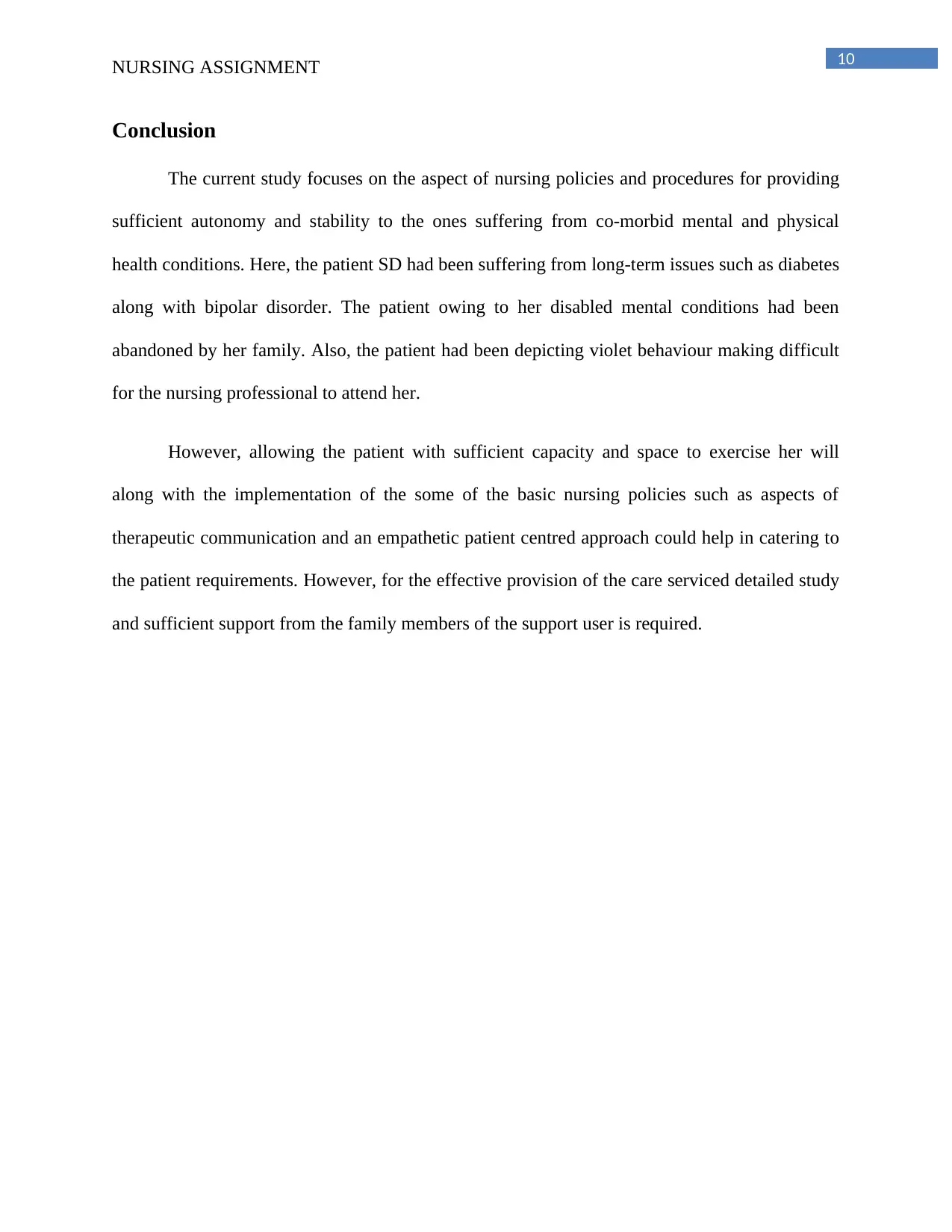
10NURSING ASSIGNMENT
Conclusion
The current study focuses on the aspect of nursing policies and procedures for providing
sufficient autonomy and stability to the ones suffering from co-morbid mental and physical
health conditions. Here, the patient SD had been suffering from long-term issues such as diabetes
along with bipolar disorder. The patient owing to her disabled mental conditions had been
abandoned by her family. Also, the patient had been depicting violet behaviour making difficult
for the nursing professional to attend her.
However, allowing the patient with sufficient capacity and space to exercise her will
along with the implementation of the some of the basic nursing policies such as aspects of
therapeutic communication and an empathetic patient centred approach could help in catering to
the patient requirements. However, for the effective provision of the care serviced detailed study
and sufficient support from the family members of the support user is required.
Conclusion
The current study focuses on the aspect of nursing policies and procedures for providing
sufficient autonomy and stability to the ones suffering from co-morbid mental and physical
health conditions. Here, the patient SD had been suffering from long-term issues such as diabetes
along with bipolar disorder. The patient owing to her disabled mental conditions had been
abandoned by her family. Also, the patient had been depicting violet behaviour making difficult
for the nursing professional to attend her.
However, allowing the patient with sufficient capacity and space to exercise her will
along with the implementation of the some of the basic nursing policies such as aspects of
therapeutic communication and an empathetic patient centred approach could help in catering to
the patient requirements. However, for the effective provision of the care serviced detailed study
and sufficient support from the family members of the support user is required.
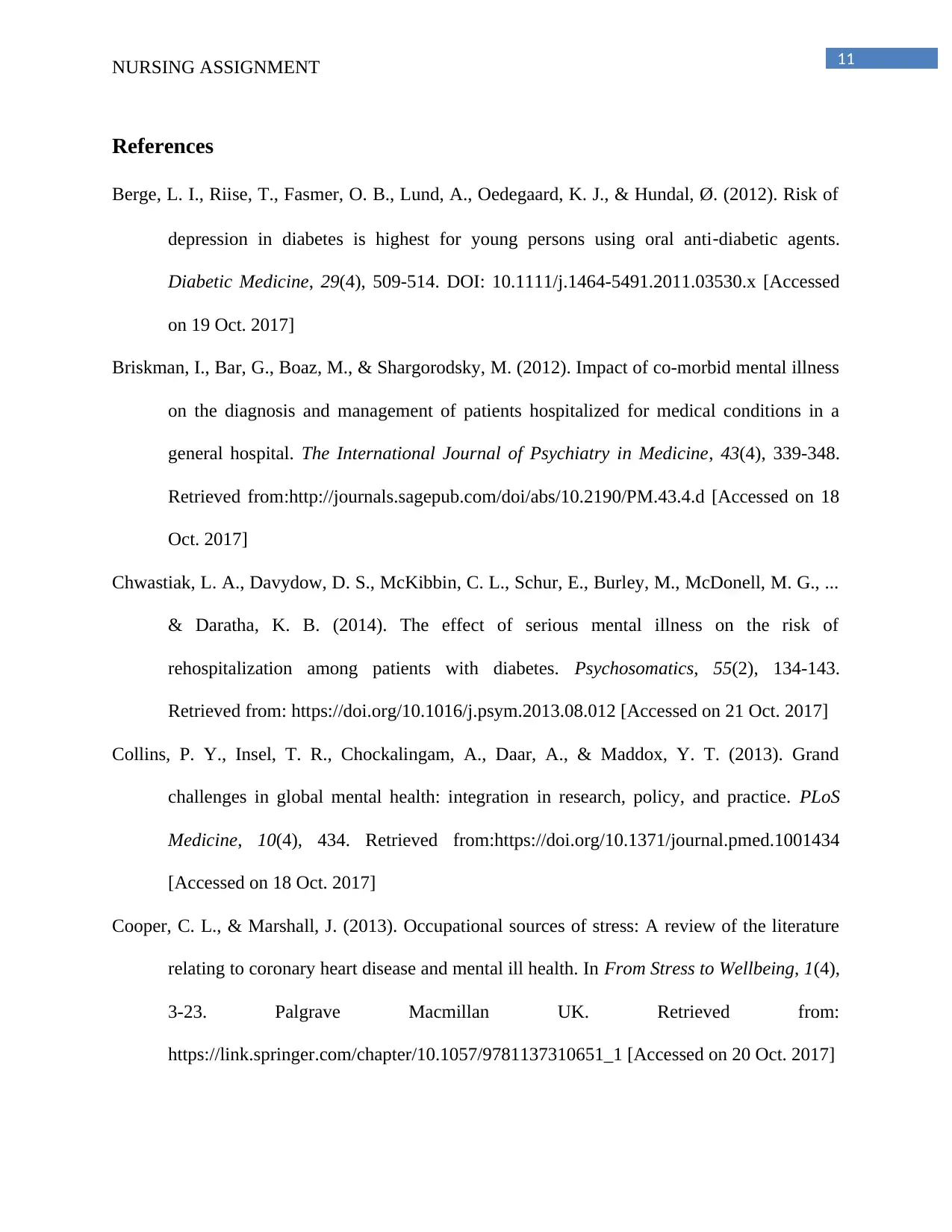
11NURSING ASSIGNMENT
References
Berge, L. I., Riise, T., Fasmer, O. B., Lund, A., Oedegaard, K. J., & Hundal, Ø. (2012). Risk of
depression in diabetes is highest for young persons using oral anti‐diabetic agents.
Diabetic Medicine, 29(4), 509-514. DOI: 10.1111/j.1464-5491.2011.03530.x [Accessed
on 19 Oct. 2017]
Briskman, I., Bar, G., Boaz, M., & Shargorodsky, M. (2012). Impact of co-morbid mental illness
on the diagnosis and management of patients hospitalized for medical conditions in a
general hospital. The International Journal of Psychiatry in Medicine, 43(4), 339-348.
Retrieved from:http://journals.sagepub.com/doi/abs/10.2190/PM.43.4.d [Accessed on 18
Oct. 2017]
Chwastiak, L. A., Davydow, D. S., McKibbin, C. L., Schur, E., Burley, M., McDonell, M. G., ...
& Daratha, K. B. (2014). The effect of serious mental illness on the risk of
rehospitalization among patients with diabetes. Psychosomatics, 55(2), 134-143.
Retrieved from: https://doi.org/10.1016/j.psym.2013.08.012 [Accessed on 21 Oct. 2017]
Collins, P. Y., Insel, T. R., Chockalingam, A., Daar, A., & Maddox, Y. T. (2013). Grand
challenges in global mental health: integration in research, policy, and practice. PLoS
Medicine, 10(4), 434. Retrieved from:https://doi.org/10.1371/journal.pmed.1001434
[Accessed on 18 Oct. 2017]
Cooper, C. L., & Marshall, J. (2013). Occupational sources of stress: A review of the literature
relating to coronary heart disease and mental ill health. In From Stress to Wellbeing, 1(4),
3-23. Palgrave Macmillan UK. Retrieved from:
https://link.springer.com/chapter/10.1057/9781137310651_1 [Accessed on 20 Oct. 2017]
References
Berge, L. I., Riise, T., Fasmer, O. B., Lund, A., Oedegaard, K. J., & Hundal, Ø. (2012). Risk of
depression in diabetes is highest for young persons using oral anti‐diabetic agents.
Diabetic Medicine, 29(4), 509-514. DOI: 10.1111/j.1464-5491.2011.03530.x [Accessed
on 19 Oct. 2017]
Briskman, I., Bar, G., Boaz, M., & Shargorodsky, M. (2012). Impact of co-morbid mental illness
on the diagnosis and management of patients hospitalized for medical conditions in a
general hospital. The International Journal of Psychiatry in Medicine, 43(4), 339-348.
Retrieved from:http://journals.sagepub.com/doi/abs/10.2190/PM.43.4.d [Accessed on 18
Oct. 2017]
Chwastiak, L. A., Davydow, D. S., McKibbin, C. L., Schur, E., Burley, M., McDonell, M. G., ...
& Daratha, K. B. (2014). The effect of serious mental illness on the risk of
rehospitalization among patients with diabetes. Psychosomatics, 55(2), 134-143.
Retrieved from: https://doi.org/10.1016/j.psym.2013.08.012 [Accessed on 21 Oct. 2017]
Collins, P. Y., Insel, T. R., Chockalingam, A., Daar, A., & Maddox, Y. T. (2013). Grand
challenges in global mental health: integration in research, policy, and practice. PLoS
Medicine, 10(4), 434. Retrieved from:https://doi.org/10.1371/journal.pmed.1001434
[Accessed on 18 Oct. 2017]
Cooper, C. L., & Marshall, J. (2013). Occupational sources of stress: A review of the literature
relating to coronary heart disease and mental ill health. In From Stress to Wellbeing, 1(4),
3-23. Palgrave Macmillan UK. Retrieved from:
https://link.springer.com/chapter/10.1057/9781137310651_1 [Accessed on 20 Oct. 2017]
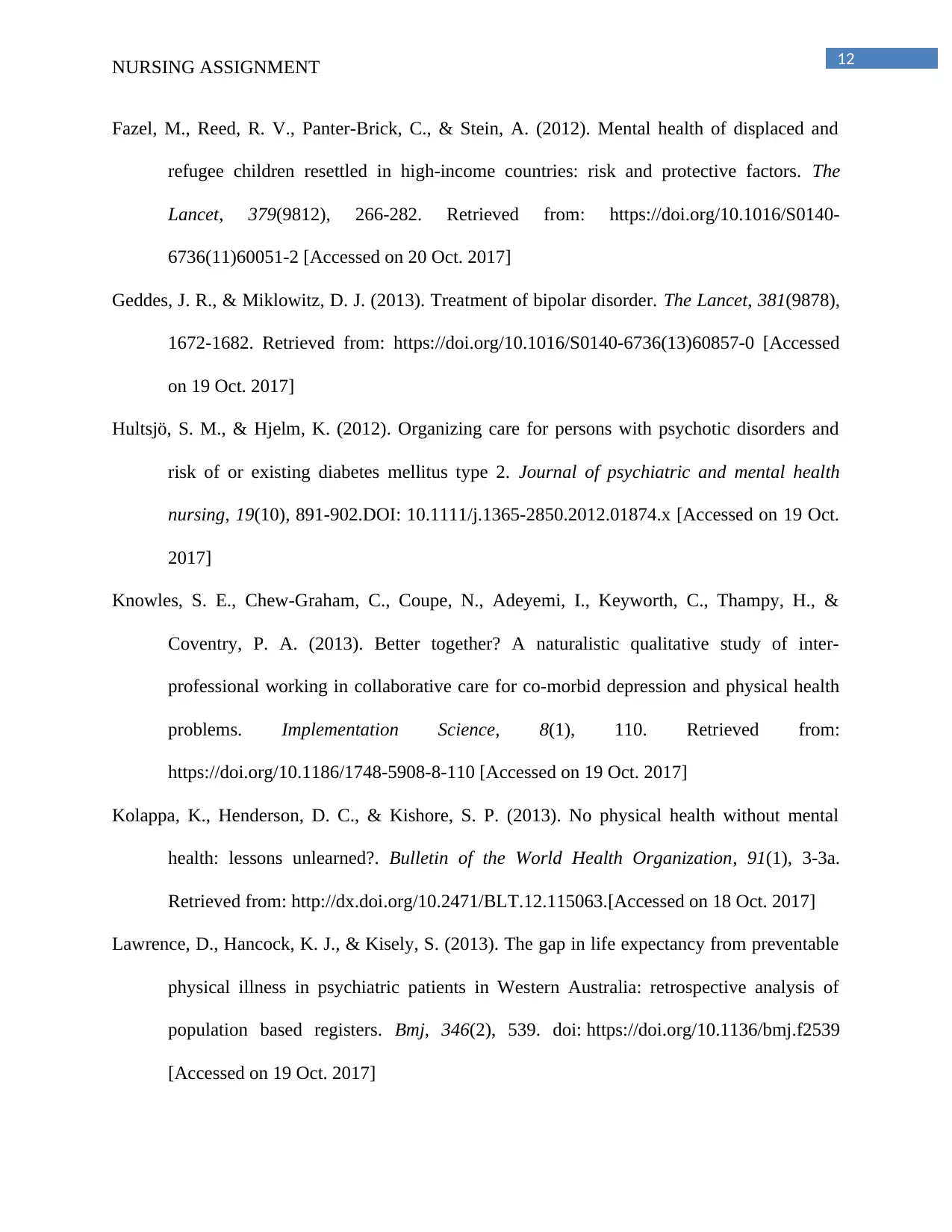
12NURSING ASSIGNMENT
Fazel, M., Reed, R. V., Panter-Brick, C., & Stein, A. (2012). Mental health of displaced and
refugee children resettled in high-income countries: risk and protective factors. The
Lancet, 379(9812), 266-282. Retrieved from: https://doi.org/10.1016/S0140-
6736(11)60051-2 [Accessed on 20 Oct. 2017]
Geddes, J. R., & Miklowitz, D. J. (2013). Treatment of bipolar disorder. The Lancet, 381(9878),
1672-1682. Retrieved from: https://doi.org/10.1016/S0140-6736(13)60857-0 [Accessed
on 19 Oct. 2017]
Hultsjö, S. M., & Hjelm, K. (2012). Organizing care for persons with psychotic disorders and
risk of or existing diabetes mellitus type 2. Journal of psychiatric and mental health
nursing, 19(10), 891-902.DOI: 10.1111/j.1365-2850.2012.01874.x [Accessed on 19 Oct.
2017]
Knowles, S. E., Chew-Graham, C., Coupe, N., Adeyemi, I., Keyworth, C., Thampy, H., &
Coventry, P. A. (2013). Better together? A naturalistic qualitative study of inter-
professional working in collaborative care for co-morbid depression and physical health
problems. Implementation Science, 8(1), 110. Retrieved from:
https://doi.org/10.1186/1748-5908-8-110 [Accessed on 19 Oct. 2017]
Kolappa, K., Henderson, D. C., & Kishore, S. P. (2013). No physical health without mental
health: lessons unlearned?. Bulletin of the World Health Organization, 91(1), 3-3a.
Retrieved from: http://dx.doi.org/10.2471/BLT.12.115063.[Accessed on 18 Oct. 2017]
Lawrence, D., Hancock, K. J., & Kisely, S. (2013). The gap in life expectancy from preventable
physical illness in psychiatric patients in Western Australia: retrospective analysis of
population based registers. Bmj, 346(2), 539. doi: https://doi.org/10.1136/bmj.f2539
[Accessed on 19 Oct. 2017]
Fazel, M., Reed, R. V., Panter-Brick, C., & Stein, A. (2012). Mental health of displaced and
refugee children resettled in high-income countries: risk and protective factors. The
Lancet, 379(9812), 266-282. Retrieved from: https://doi.org/10.1016/S0140-
6736(11)60051-2 [Accessed on 20 Oct. 2017]
Geddes, J. R., & Miklowitz, D. J. (2013). Treatment of bipolar disorder. The Lancet, 381(9878),
1672-1682. Retrieved from: https://doi.org/10.1016/S0140-6736(13)60857-0 [Accessed
on 19 Oct. 2017]
Hultsjö, S. M., & Hjelm, K. (2012). Organizing care for persons with psychotic disorders and
risk of or existing diabetes mellitus type 2. Journal of psychiatric and mental health
nursing, 19(10), 891-902.DOI: 10.1111/j.1365-2850.2012.01874.x [Accessed on 19 Oct.
2017]
Knowles, S. E., Chew-Graham, C., Coupe, N., Adeyemi, I., Keyworth, C., Thampy, H., &
Coventry, P. A. (2013). Better together? A naturalistic qualitative study of inter-
professional working in collaborative care for co-morbid depression and physical health
problems. Implementation Science, 8(1), 110. Retrieved from:
https://doi.org/10.1186/1748-5908-8-110 [Accessed on 19 Oct. 2017]
Kolappa, K., Henderson, D. C., & Kishore, S. P. (2013). No physical health without mental
health: lessons unlearned?. Bulletin of the World Health Organization, 91(1), 3-3a.
Retrieved from: http://dx.doi.org/10.2471/BLT.12.115063.[Accessed on 18 Oct. 2017]
Lawrence, D., Hancock, K. J., & Kisely, S. (2013). The gap in life expectancy from preventable
physical illness in psychiatric patients in Western Australia: retrospective analysis of
population based registers. Bmj, 346(2), 539. doi: https://doi.org/10.1136/bmj.f2539
[Accessed on 19 Oct. 2017]
Paraphrase This Document
Need a fresh take? Get an instant paraphrase of this document with our AI Paraphraser
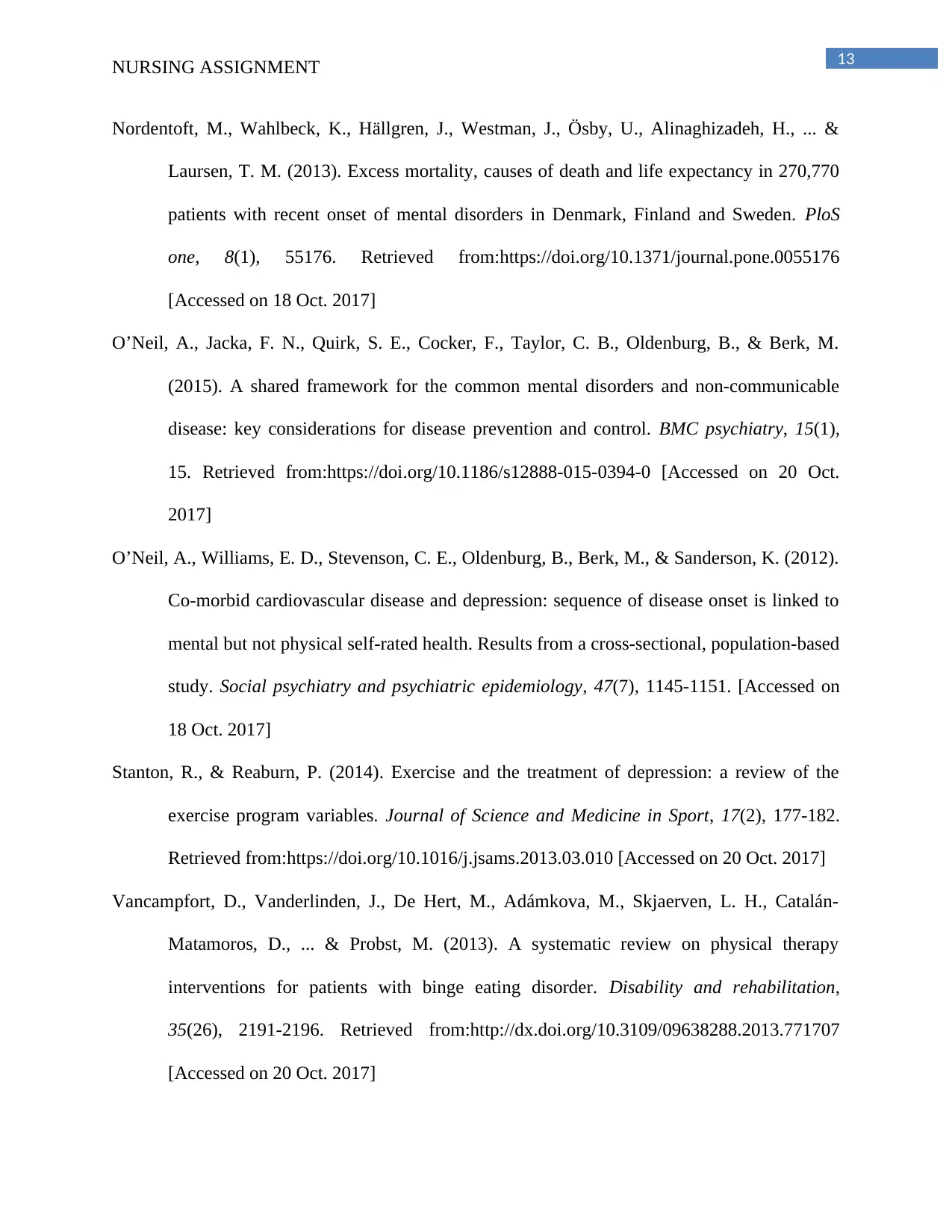
13NURSING ASSIGNMENT
Nordentoft, M., Wahlbeck, K., Hällgren, J., Westman, J., Ösby, U., Alinaghizadeh, H., ... &
Laursen, T. M. (2013). Excess mortality, causes of death and life expectancy in 270,770
patients with recent onset of mental disorders in Denmark, Finland and Sweden. PloS
one, 8(1), 55176. Retrieved from:https://doi.org/10.1371/journal.pone.0055176
[Accessed on 18 Oct. 2017]
O’Neil, A., Jacka, F. N., Quirk, S. E., Cocker, F., Taylor, C. B., Oldenburg, B., & Berk, M.
(2015). A shared framework for the common mental disorders and non-communicable
disease: key considerations for disease prevention and control. BMC psychiatry, 15(1),
15. Retrieved from:https://doi.org/10.1186/s12888-015-0394-0 [Accessed on 20 Oct.
2017]
O’Neil, A., Williams, E. D., Stevenson, C. E., Oldenburg, B., Berk, M., & Sanderson, K. (2012).
Co-morbid cardiovascular disease and depression: sequence of disease onset is linked to
mental but not physical self-rated health. Results from a cross-sectional, population-based
study. Social psychiatry and psychiatric epidemiology, 47(7), 1145-1151. [Accessed on
18 Oct. 2017]
Stanton, R., & Reaburn, P. (2014). Exercise and the treatment of depression: a review of the
exercise program variables. Journal of Science and Medicine in Sport, 17(2), 177-182.
Retrieved from:https://doi.org/10.1016/j.jsams.2013.03.010 [Accessed on 20 Oct. 2017]
Vancampfort, D., Vanderlinden, J., De Hert, M., Adámkova, M., Skjaerven, L. H., Catalán-
Matamoros, D., ... & Probst, M. (2013). A systematic review on physical therapy
interventions for patients with binge eating disorder. Disability and rehabilitation,
35(26), 2191-2196. Retrieved from:http://dx.doi.org/10.3109/09638288.2013.771707
[Accessed on 20 Oct. 2017]
Nordentoft, M., Wahlbeck, K., Hällgren, J., Westman, J., Ösby, U., Alinaghizadeh, H., ... &
Laursen, T. M. (2013). Excess mortality, causes of death and life expectancy in 270,770
patients with recent onset of mental disorders in Denmark, Finland and Sweden. PloS
one, 8(1), 55176. Retrieved from:https://doi.org/10.1371/journal.pone.0055176
[Accessed on 18 Oct. 2017]
O’Neil, A., Jacka, F. N., Quirk, S. E., Cocker, F., Taylor, C. B., Oldenburg, B., & Berk, M.
(2015). A shared framework for the common mental disorders and non-communicable
disease: key considerations for disease prevention and control. BMC psychiatry, 15(1),
15. Retrieved from:https://doi.org/10.1186/s12888-015-0394-0 [Accessed on 20 Oct.
2017]
O’Neil, A., Williams, E. D., Stevenson, C. E., Oldenburg, B., Berk, M., & Sanderson, K. (2012).
Co-morbid cardiovascular disease and depression: sequence of disease onset is linked to
mental but not physical self-rated health. Results from a cross-sectional, population-based
study. Social psychiatry and psychiatric epidemiology, 47(7), 1145-1151. [Accessed on
18 Oct. 2017]
Stanton, R., & Reaburn, P. (2014). Exercise and the treatment of depression: a review of the
exercise program variables. Journal of Science and Medicine in Sport, 17(2), 177-182.
Retrieved from:https://doi.org/10.1016/j.jsams.2013.03.010 [Accessed on 20 Oct. 2017]
Vancampfort, D., Vanderlinden, J., De Hert, M., Adámkova, M., Skjaerven, L. H., Catalán-
Matamoros, D., ... & Probst, M. (2013). A systematic review on physical therapy
interventions for patients with binge eating disorder. Disability and rehabilitation,
35(26), 2191-2196. Retrieved from:http://dx.doi.org/10.3109/09638288.2013.771707
[Accessed on 20 Oct. 2017]

14NURSING ASSIGNMENT

15NURSING ASSIGNMENT
1 out of 16
Related Documents
Your All-in-One AI-Powered Toolkit for Academic Success.
+13062052269
info@desklib.com
Available 24*7 on WhatsApp / Email
![[object Object]](/_next/static/media/star-bottom.7253800d.svg)
Unlock your academic potential
© 2024 | Zucol Services PVT LTD | All rights reserved.




